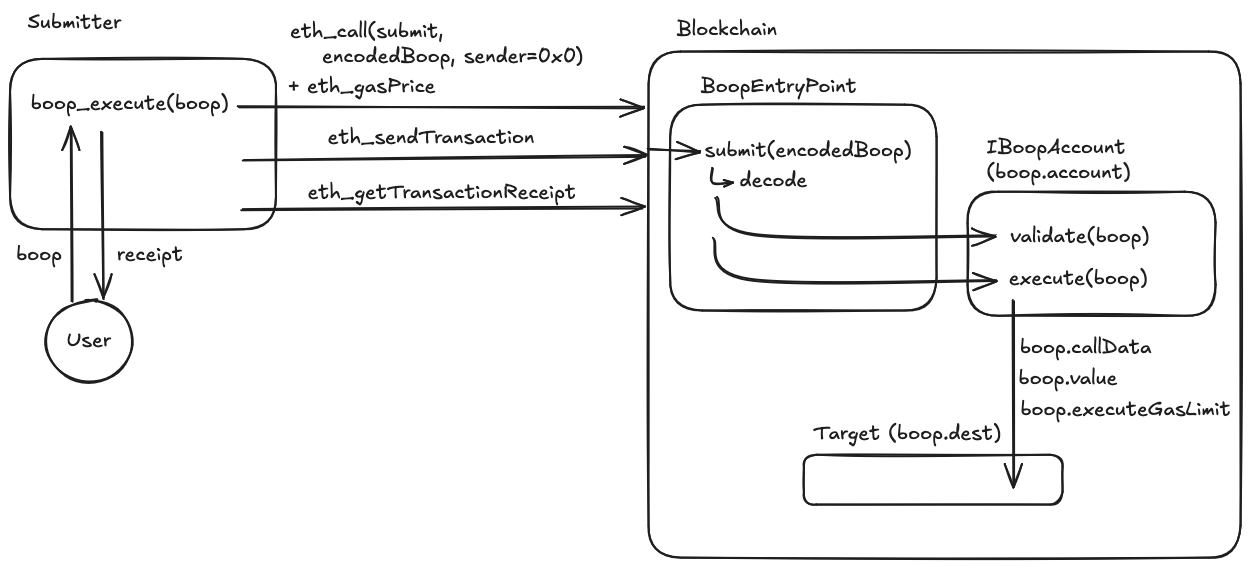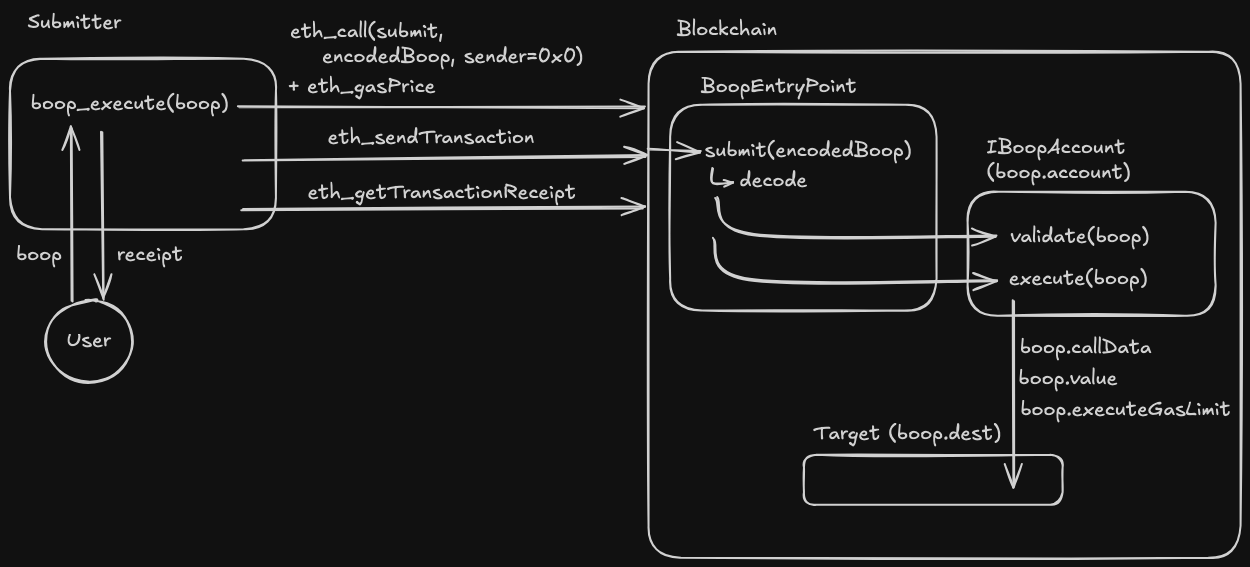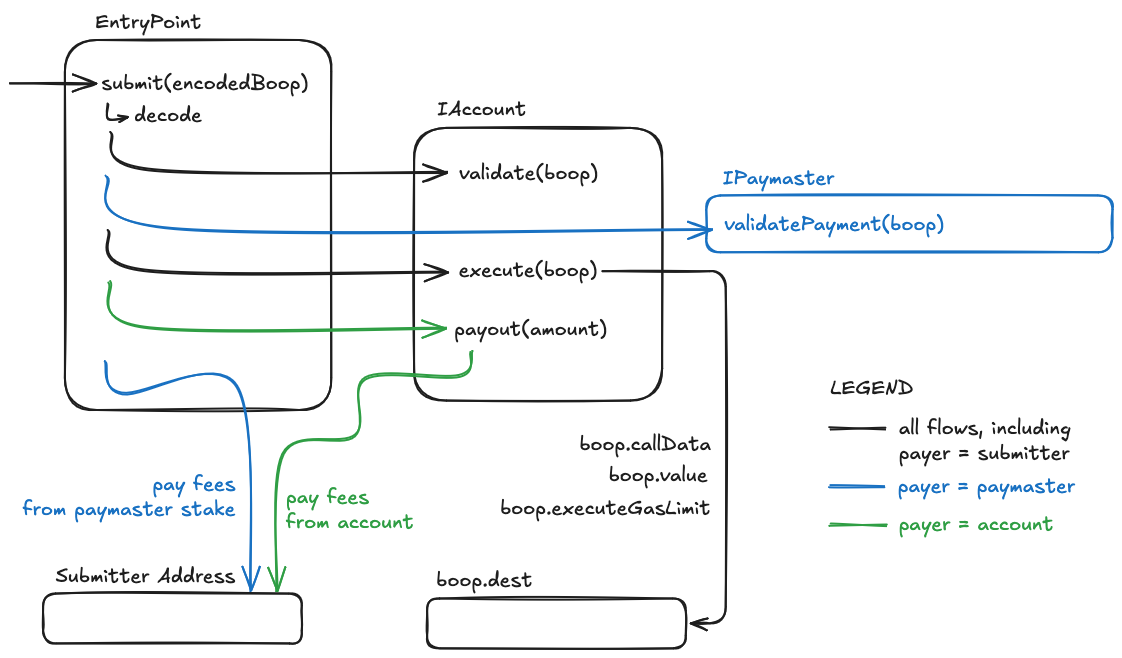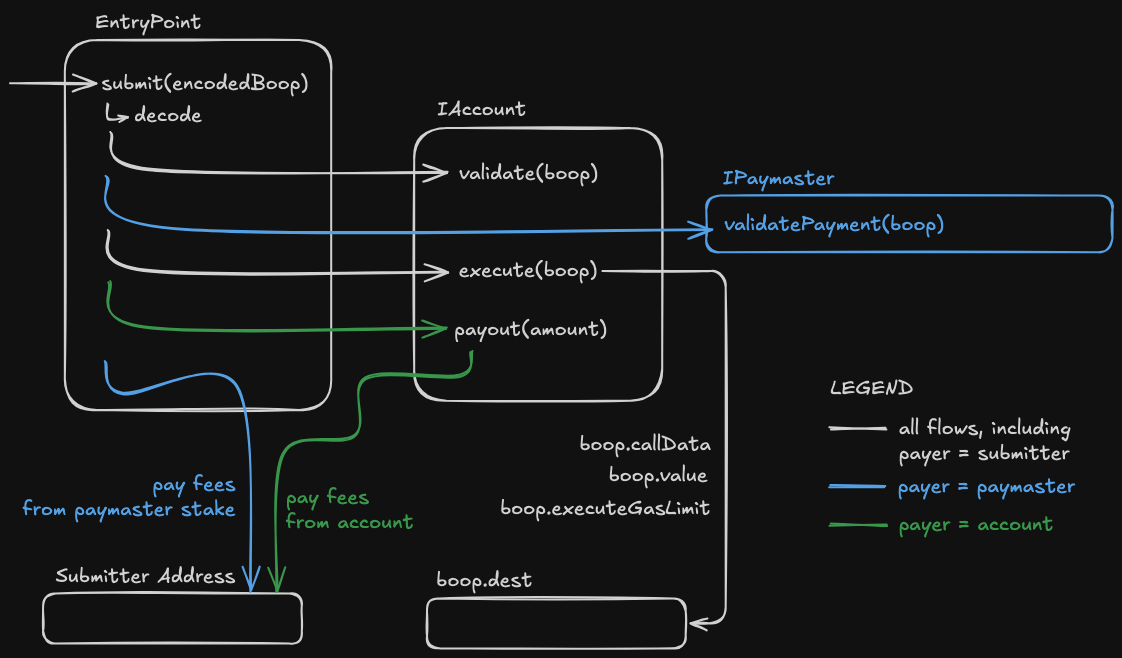Boop Architecture
Check the introduction for a quick intro to Boop. This documents details the architecture of the system.
Background
The goal of an account abstraction system is very simple: a user wants to make transactions, but their account is a smart contract. In the Boop system, we call such transactions "boops".
This immediately runs into a problem: a boop needs to be triggered by an EOA* transaction, which has to pay fees. Ideally, we don't want the user to maintain balances on both their smart account and EOA to pay fees.
* An "externally owned account", i.e. an account controlled by private key.
To avoid this you need a relayer: someone that will trigger the smart account transaction on behalf of the user, and will either front the fees, to be repaid by the smart account or a third-party (a "paymaster"), or will sponsor the fees itself. In Boop, we call this relayer "the submitter".
The Boop system involves the following "sites":
- A device from which the user wants to make transactions.
- A submitter that fronts or sponsors the transaction costs.
- A blockchain where the operation happens (and more concretely, a blockhain node that the submitter talks to).
On the blockchain itself, there are a few contracts involved:
- The
EntryPointcontract, that orchestrates boop execution. - The user's account contract.
- (optionally) A paymaster contract that pays for the user's transaction fees (refunding the submitter).
Finally, there are three options for who actually pays the fees (i.e. refunds the submitter):
- The account pays its fees itself, in which case the
payerboop field will be set to the account's address. - The submitter sponsors the boop, in which case the
payerfield is set to the zero address. No refund need to occur. - A paymaster contract sponsors the boop, in which case the
payerfield is set to its address.
Example Flow: End-to-end Boop Execution
Here's a diagram of how a Boop flows between the locations we mentioned in the previous section.
In particular, this is an execute endpoint request to the submitter, for a submitter-sponsored boop.


-
The user sends an
executerequest to the submitter, to which a boop (transaction) is attached. -
The submitter simulates this boop by sending an
eth_callRPC request to a blockchain node.-
This step is not strictly necessary but it is usual: the submitter does not want to pay fees for a failing boop.
-
Simulation is also necessary if the transaction is sponsored, in which case the user is allowed to omit fee information and gas limits — as is the case here.
-
The simulation result from the contract will provide appropriate gas limit values.
-
-
The submitter also needs to get the gas price, which we represented as an
eth_gasPricecall on this diagram. In practice, this is the same for all boops, and only needs to be done once per block for all boops. Since it's done once we become aware of the block, it will never delay a boop, which needs to wait for the next block for inclusion. -
If the simulation was successful, the submitter posts the boop onchain by making an EVM transaction carrying the boop to the
EntryPointcontract, calling itssubmitfunction. It then starts waiting for the receipt (represented here byeth_getTransactionReceipt, but can also be a WebSocket subscription). -
The boop is sent in an encoded (packed) format, so the first thing the EntryPoint contract does is decode it.
-
The EntryPoint then performs certain validatons on the boop, most importantly it validates the Boop's nonce.
-
The EntryPoint calls the
validatefunction of the user's account contract, passing it the boop. This function's role is to validate that the boop is legitimate. The most common way to do this is to check that it was signed with an authorized EOA, but any other scheme can be implemented. -
If validation is successful, the EntryPoint contract then calls the
executefunction of the user's account contract. This function is responsible to acually carry out the intent of the boop — most likely that is making a call to another target contract, and the boop structure contains fields dedicated to this. -
In this scenario, the submitter sponsors the fee, so there isn't a need for fee payment logic.
Contracts Overview
Boop execution (besides any call that would be specified by the boop itself) involve two or three contracts:
- The
EntryPointcontract, that orchestrates the execution of the boop. - An account contract implementing
IAccount, which validates and excutes the boop. - An optional paymaster contract (specified in the
payerfield of the boop) implementingIPaymaster, which pays the boop's fees (to the submitter, which fronts the blockchain fees and may charge their own fee).
Here's a diagram that shows the interaction between those:


There are three possible flows:
- When the submitter pays for the fees (
boop.payer === address(0)), then only the black lines are followed. - If the account pays for the boop (
boop.payer === boop.account), follow the black and green lines. - If a paymaster pays for the boop, (
boop.payercontains paymaster address), follow the black and blue lines.
For more details about how the Boop contract function and can be implemented, refer to the Boop Contracts section.
Account Extensions
Accounts can be extends with validation and execution extensions, which can be modify how boops are validated and executed. Refer to the Extensions page for more information.
Account Deployment
Unlike ERC-4337, the Boop contracts make no special provision for account deployment. They have to be deployed in advance, prior to the first boop being submitted to the account.
Our submitter implementation (see below) enables deploying accounts on behalf of users.
On testnet, we deploy every account behind a beacon proxy, this enables us to upgrade all the accounts at once by changing the implementation address in the beacon. This is of course not suitale for mainnet deployments!
On mainnet, every account will be deployed behind a UUPS proxy.
In both cases, we have a factory contract that handles deploying these proxies, and the factory records the address in an account registry. This is an important technique, as it is the only way to ascertain the implementation used by an account, which can be useful as malicious account implemention can attempt to grief the submitter.
Note that if the accounts are upgreadable by their owner (as our UUPS proxies are), it is important to deregister the account from the registry when they independently upgrade. Also note our current implementation doesn't do this (but this isn't used at the moment, as we are still on the testnet beacon proxies).
You can check out our proxies, factories and registry contracts here.
Submitter Overview
The submitter is the entity that submits boops to the blockchain, either sponsoring the fees needed to do so, or fronting them, to be repaid by the account itself or by a paymaster. Users can also submit boops directly, but they will need a funded EOA to pay the blockchain fees.
The Boop contracts don't need a standard submitter to be used, anybody can come up with their own implementation.
Happy Devs maintains an open-source submitter implementation, which exposes a REST API to submit boops and query boop-related information. Below is an overview of the exposed endpoints, which a fully specified on the REST API page.
-
/api/v1/accounts/create— deploys a new account given an owner EOA and a salt. -
/api/v1/boop/simulate— simulates the provided boop and returns the simulation result: sucess or failure (+ reason), estimated gas limits, whether some information is missing to pass validation, ... -
/api/v1/boop/submit— submits the provided boop to the blockchain, returning the boop hash if successful. -
/api/v1/boop/waitForReceipt— waits for the receipt of the given boop hash to be available and returns it. -
/api/v1/boop/execute— basicallysubmitandwaitForReceiptwrapped into one — this is what we recommend using for optimal latency. -
/api/v1/boop/getState— returns a instant snapshot of the current state of the boop with the given boop hash, this can return a simulation result, a receipt, or an indication that the boop is not currently being processed by the submitter and that no receipt is available for it. -
/api/v1/boop/getPending— returns all boops being processed for a given account, i.e. all the boops that are awaiting either being submitted to the chain, or for their receipt to be available.
The Boop client SDK provides typed functions to easily make calls to our submitter implementation (or to any other implementation that exposes the same REST API) from JavaScript or TypeScript.
To learn more about the submitter implementation, refer to the Boop Submitter section.
Boop Client SDK Overview
The Boop client SDK allows to easily call the submitter via the REST API in JavaScript and TypeScript, with full type safety for the latter. It also supplies a few utilities functions to work with boops (encoding etc).
See the Boop Client SDK page for more information.
